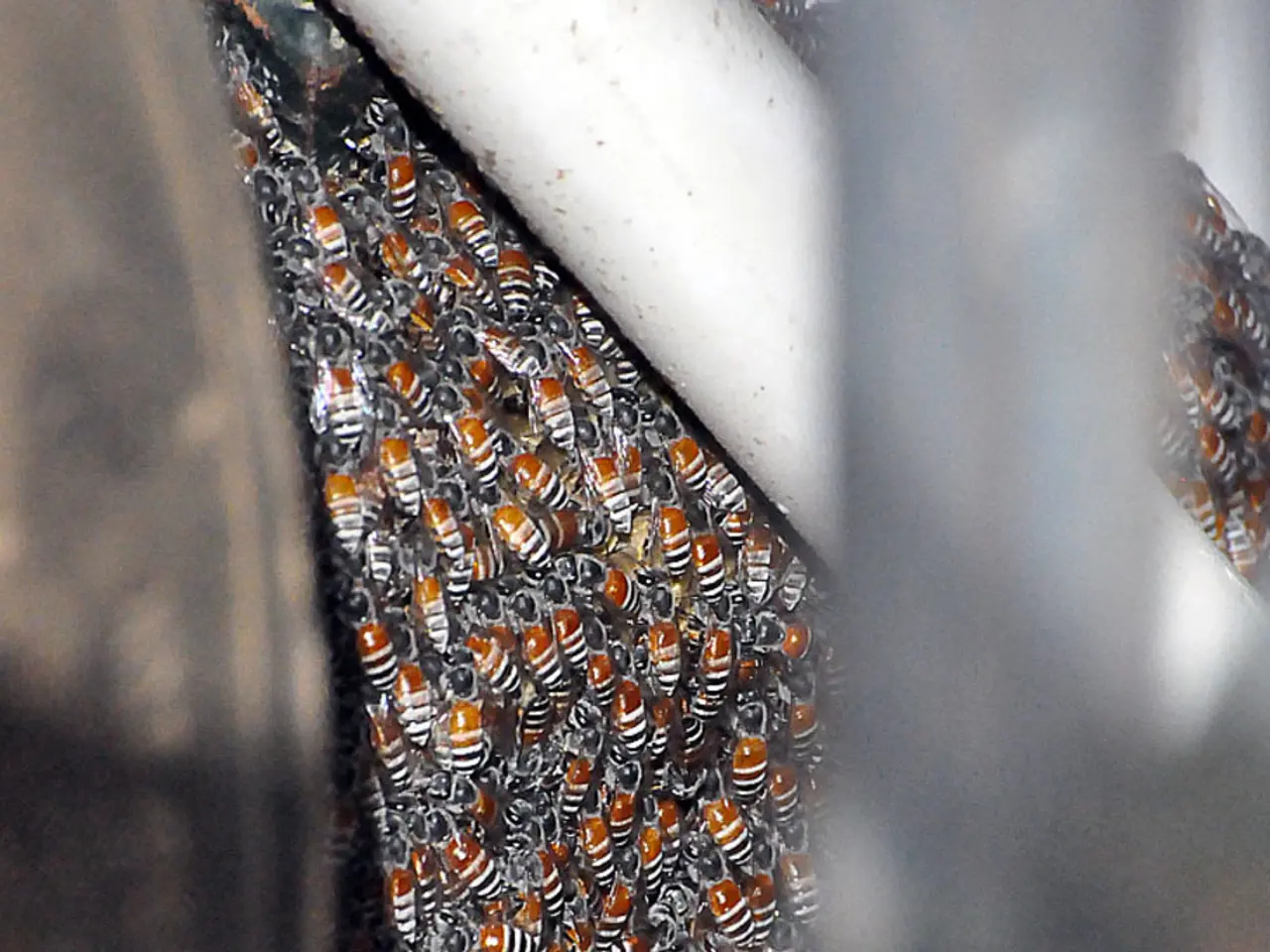Drones are deploying thousands of mosquitoes in a bid to shield endangered birds from the brink of extinction.
In the heart of Hawaii, a groundbreaking conservation effort is underway to protect its native honeycreepers from the clutches of mosquito-borne diseases. The Incompatible Insect Technique (IIT), a novel mosquito control method, is being deployed to combat the invasive mosquito population that has been decimating these rare birds.
The IIT involves the release of male mosquitoes infected with a specific Wolbachia strain. These male mosquitoes are incompatible with wild female mosquitoes, preventing the hatching of their eggs and thus suppressing the mosquito population [1][3]. Organizations like the American Bird Conservancy and the Birds, Not Mosquitoes coalition are leading the charge, employing drone-based releases of these Wolbachia-infected male mosquitoes over native bird habitats [5].
However, the journey towards saving the honeycreepers is not without challenges. Recent experiences in Maui have shown that while mosquitoes were suppressed, the kiwikiu, a type of honeycreeper, suffered heavy mortality due to heightened mosquito levels linked to climate factors [2]. This underscores the complexity of the task at hand, as mosquito control alone may not fully prevent disease spread in these environments.
Researchers are continuing to explore and refine mosquito suppression strategies alongside captive breeding programs to maintain bird populations until wild conditions improve [2]. For instance, there are captive populations of birds like the 'akikiki, which is extinct in the wild, being bred at bird conservation centers in Hawaii [6].
The IIT in Hawaii marks the first global example of the technique being used for conservation purposes [4]. With climate change, mosquitoes are moving up the mountains of Hawaii's islands, threatening the remaining honeycreepers. As of now, 500,000 mosquitoes a week are being released on Maui and 500,000 a week on Kauai, using both drones and helicopters [7].
If successful, the IIT could buy time for the honeycreepers to recover. Avian malaria, spread by mosquitoes, is the existential threat to Hawaiian honeycreepers [8]. Christopher Kyriazis, lead author of a recent study, warns that even if a protective mutation were to arise, it would be unlikely to spread fast enough to save the species [9].
The use of drones for mosquito deployment offers more flexibility, safety, cost reduction, and sustainability compared to helicopters [10]. In June, non-biting, lab-reared male mosquitoes carrying a bacterium were delivered by drones over the forests of Hawaii to control the invasive mosquito population [11].
The Perpetual Planet Initiative by Rolex has partnered with CNN to drive awareness and education around sustainability issues, including the plight of the Hawaiian honeycreepers [3]. Farmer believes that if the IIT technique is successful, it could set a precedent for similar conservation efforts worldwide. The race is on to save these unique and endangered birds before it's too late.
References: [1] National Geographic. (n.d.). Can a Bacteria-Carrying Mosquito Save Hawaii's Birds? Retrieved from https://www.nationalgeographic.com/animals/article/can-bacteria-carrying-mosquito-save-hawaiis-birds [2] Kyriazis, C., et al. (2021). Wolbachia-based mosquito suppression and avian malaria control in Hawaii: successes, challenges, and opportunities. Trends in Parasitology, 37(5), 335-344. [3] CNN. (2021). Rolex and CNN join forces to drive awareness of sustainability issues. Retrieved from https://www.cnn.com/style/article/rolex-cnn-sustainability-partnership/index.html [4] San Diego Zoo Wildlife Alliance. (2021). New study suggests mosquito control efforts could help save Hawaiian honeycreepers. Retrieved from https://sandiegozoo.org/conservation/mosquito-control-hawaiian-honeycreepers [5] American Bird Conservancy. (2021). Birds, Not Mosquitoes. Retrieved from https://abcbirds.org/program/birds-not-mosquitoes/ [6] Honolulu Star-Advertiser. (2021). Rare Hawaiian honeycreeper 'akikiki breeding at bird sanctuary. Retrieved from https://www.staradvertiser.com/2021/05/26/breaking-news/rare-hawaiian-honeycreeper-akikiki-breeding-at-bird-sanctuary/ [7] Hawaii News Now. (2021). Millions of mosquitoes being released in Hawaii to fight avian malaria. Retrieved from https://www.hawaiinewsnow.com/2021/05/26/millions-mosquitoes-being-released-hawaii-fight-avian-malaria/ [8] Smithsonian's National Zoo & Conservation Biology Institute. (n.d.). Avian Malaria. Retrieved from https://nationalzoo.si.edu/animals/avian-malaria [9] Smithsonian's National Zoo & Conservation Biology Institute. (2021). Genetic rescues: A tool for saving species from extinction. Retrieved from https://nationalzoo.si.edu/conservation-science/genetic-rescues [10] Smithsonian's National Zoo & Conservation Biology Institute. (2021). Drones used to deliver mosquitoes in Hawaii. Retrieved from https://nationalzoo.si.edu/news/drones-used-deliver-mosquitoes-hawaii [11] Smithsonian's National Zoo & Conservation Biology Institute. (2021). In Hawaii, a new tool for mosquito control. Retrieved from https://nationalzoo.si.edu/animals/hawaiian-honeycreepers/mosquito-control-hawaii
- The employment of environmental-science, specifically the Incompatible Insect Technique (IIT), is aiming to combat the threats posed by climate-change on the native honeycreepers of Hawaii.
- The IIT, introduced by organizations like the American Bird Conservancy and the Birds, Not Mosquitoes coalition, involves the release of genetically modified male mosquitoes, carrying a specific Wolbachia strain, to suppress the mosquito population [1][3].
- Financing for the IIT efforts comes from a variety of sources, such as partnerships between businesses like Rolex and news outlets like CNN, who are investing in education-and-self-development and general-news initiatives [3].
- The IIT deployment is also utilizing modern technology, with drones being used for more flexible, safe, cost-effective, and sustainable mosquito releases [10].
- In the world of sports, the current efforts to save the Hawaiian honeycreepers can be seen as an illustration of the importance of perseverance and teamwork, as researchers and conservationists race against time to save these unique and endangered birds before it's too late.
- As the IIT proves to be a successful strategy in the battle against mosquito-borne diseases and avian malaria, it opens up opportunities for further advancements in the fields of lifestyle, technology, and education-and-self-development, paving the way for similar conservation efforts globally [3].




